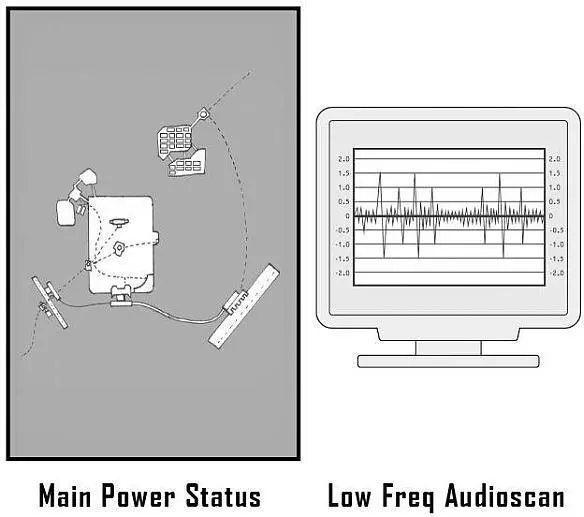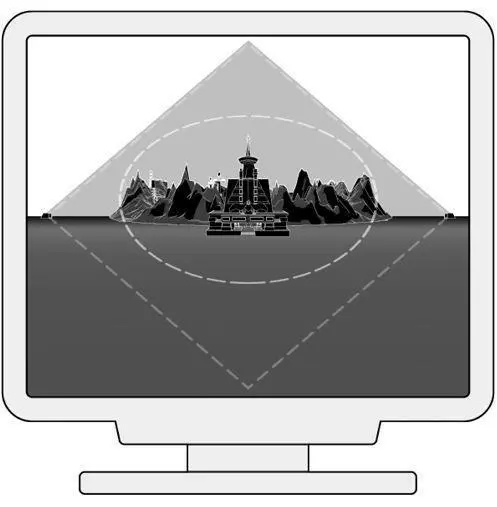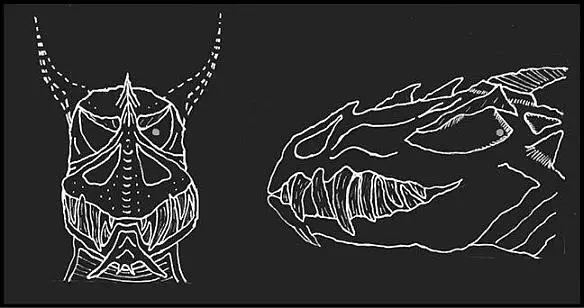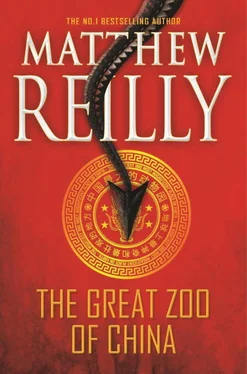‘Hours of fun for the whole family,’ Hamish said as he took more shots with his camera.
‘Yes,’ Zhang said enthusiastically, not sensing the sarcasm.
CJ’s eyes ran over some of the other monitors in the master control room. She saw one which looked like an overhead map of the crater and its surrounds, and another that looked like a seismograph:

She was about to ask about them when Hamish said to Hu, ‘Hey, dude, I don’t want to be the jerk who asks the obvious question, but what’s keeping your pet lizards inside this crater? There’s no roof or cage above this valley. Why don’t they just fly out of here?’
Hu smiled kindly. ‘That is a very good question and this is the best place to answer it. Ladies and gentlemen, if I may draw your attention to this console over here…’ He stepped behind a Chinese technician at a computer.
On the computer’s screen was a digital image of the zoo:

‘Mr Cameron’s question,’ Hu said, ‘is a very astute one. When we conceived the Great Dragon Zoo, we didn’t want it to look like a prison. We wanted visitors to see our dragons as they were meant to be seen: soaring against the wide open sky.’
He held up a finger. ‘Having said that, our dragons are still very much our prisoners. As you will see on this display, there are two barriers—invisible to the human eye—keeping our dragons captive here inside the zoo.
‘They are electromagnetic fields. The first and innermost field is in the shape of a dome, the second is in the shape of a pyramid. The first covers only this valley, the second covers a much larger area around the valley. The two domes are essentially invisible walls of ultra-high-voltage electromagnetic energy. They also, I should add, extend underground, just in case our dragons attempt to tunnel their way out of here.
‘Now, as Deputy Director Zhang mentioned earlier, each dragon has a microchip grafted onto its brain.’
He indicated another nearby screen, on which was an x-ray image of a dragon skull seen from the front and from the side. CJ saw the chip situated immediately behind the left eye of the skull:

‘That chip,’ Hu said, ‘is actually fitted to the limbic or pain centre of the dragon’s brain and it is capable of emitting a powerful electric shock in certain circumstances. One of those circumstances is when a dragon comes into contact with either of the electromagnetic domes.’
CJ recalled the yellow remote from the trick show and wondered if that was another such ‘circumstance’.
Hu said, ‘If a dragon touches one of our domes, it will experience a shock sent directly into the pain centre of its brain. This, I can assure you, is an exceedingly painful experience.’
‘How painful?’ Wolfe asked.
‘If a dragon hits that dome,’ Hu said, ‘it will black out instantly and drop from the sky. The dragons learned very quickly not to touch the inner dome.’ He rounded on Hamish. ‘And, as a matter of fact, Mr Cameron, we did see Jurassic Park . From a very early stage in the development of this facility, we were cognisant of the dragons’ dangerous potential.
‘Make no mistake, my dear guests, these are dangerous animals and we know it. But then this is why people go to zoos in the first place: to see the dangerous animals. The tigers, the bears, the alligators. But we must also recognise that these are important animals, the likes of which the modern world has never seen. As such, we have endeavoured to develop systems that contain our dragons without unnecessarily damaging them. Wire fences, steel walls, even visible lasers were all no good. We want to alter our animals’ behaviour without harming them and we want our visitors to see our animals without the crude intervention of bars. The electromagnetic domes have worked perfectly in containing them.’
‘What about protecting your visitors?’ Perry said.
Hu smiled again and CJ had the distinct feeling that Aaron Perry had been the sucker who asked the question Hu had been waiting for.
‘Have a look in your gift pack,’ Hu said, ‘and please take from it the rather unusual pair of sunglasses that came with it.’
CJ and the others all pulled from their fanny packs the strange-looking oversized sunglasses.
‘Put them on,’ Hu invited.
CJ put on her sunglasses and looked out the bank of windows.
‘Whoa…’ she breathed.
Whereas before she had seen the wide valley surmounted by empty sky, now she saw a grid of iridescent green laser-lines forming a perfect geodesic dome above it. The dome stretched from wall to wall, rising up and over the central mountain, completely and perfectly containing the massive space. All the dragons flew and wheeled within it.
Above the green dome, she glimpsed another laser-like lattice: this one was reddish in colour and it looked more flat-sided than dome-shaped.
‘What you are seeing now,’ Hu said, ‘is what a dragon sees. Your odd-looking sunglasses depict the ultraviolet spectrum of light. This is how dragons view the world. Incidentally, modern birds also see this way. Every shield at the zoo is shot through with ultraviolet beams so the dragons can see them.’
CJ was more enthralled than impressed. She found it fascinating to see the world through an animal’s eyes. Being able to see ultraviolet light gave a predator several advantages, including the ability to spot the urine trails of prey. In the ultraviolet spectrum, urine glowed like neon. That was how hawks and falcons spotted their prey on the ground.
As she scanned the megavalley, taking in the environment as a dragon would see it, she saw many tiny ultraviolet spheres of a third colour: light blue.
The glowing blue spheres—invisible to the naked eye, but visible through the glasses—enveloped all the cable cars, every building in the valley, and even all the worker trucks she could see moving along the roads of the zoo.
There were dozens of the shields, but if you weren’t wearing the glasses you’d never know they existed.
‘What are the blue shiel—’ she asked, turning to look back at her fellow travellers.
She cut herself off.
Each of them , including herself, had a small pale blue shield around their body.
‘Ah-ha…’ she said.
Hu noticed. ‘As Dr Cameron has just discovered, if you look through your glasses at each other, you will see why our dragons do not touch any of our guests.
‘The designer wristwatch that each of you was given on your arrival here at the zoo emits a small but very powerful ultrasonic field around your body—it is essentially a sphere of high-wavelength sonic energy beyond the range of human hearing. But a dragon has exceptional hearing. They can hear on wavelengths undetectable to the human ear. This is great for hunting but our clever engineers at the Great Dragon Zoo have used this talent against them. To a dragon, the sound emitted by your watch is absolutely ear-piercing—it would be like someone sounding an air-horn right next to your ear.’
Zhang added, ‘You will notice small antennas on every vehicle and structure in the valley. These emit similar ultrasonic shields. Dragons are not exactly small animals. If one brushed against a cable car, even by accident, it would do significant damage.’
Читать дальше














